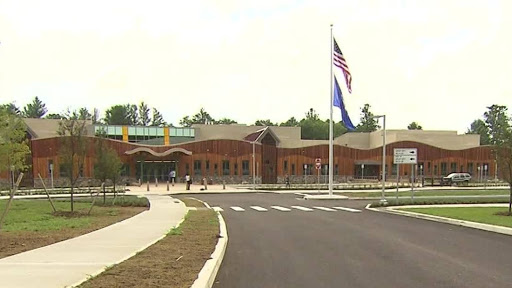
Day 28: Motoring Through Massachusetts to My Great Aunt’s Famous House
April 16, 2021
Day 26: From Jersey to Connecticut’s Gold Coast
April 14, 2021Most recently updated on March 27, 2024
Driven on July 20, 2023
Originally posted on April 15, 2021
We start Day 27 in the southwest corner of Connecticut.
Before the day is out, we’ll have traveled along almost the entire coastline as well as taken a side trip to a town where we talk with the mother of one of the children lost in one of the nation’s worst school shootings.
We’ll also learn about the origins of the Frisbee, the Subway sandwich franchise and the game of Scrabble as well as visit the oldest hamburger shop in the country.
We can get all this done in one day because Connecticut is one of our smallest states. Its 4,845 square miles ranks it 48th with only Delaware and Rhode Island having less acreage.
Its 3.6 million residents place it 29th among states and 4th highest in population density. Its $90,000 annual median household income is one of the highest among states. The median home price is about $380,000.
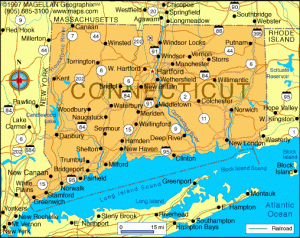
Its economy relies heavily on maritime industries as well as manufacturing and finance, in particular insurance. The fishing outfits are somewhat protected here as Long Island Sound provides a buffer from the brunt of most Atlantic storms. Oysters, crabs, clams and lobsters are harvested from its waters.
The big news in summer 2021 in the state was that recreational marijuana became legal on July 1. Under the new law, adults over the age of 21 can possess and consume small amounts of “cannabis plant material.” That law took effect on January 10, 2023. There are now 24 establishments in the state that can legally sell recreational cannabis.
The town of Greenwich is where we begin today’s journey.
This is where the Gold Coast of Connecticut starts. This coastline is a string of higher income communities that look out over the shoreline.
Greenwich has a population of 15,000 people. Its median annual household income is $128,000 and the average home costs $1.9 million. Greenwich, however, is not the highest roller on the Gold Coast. We’ll pass through some of those later.
Greenwich was settled in 1640 when the founding pioneers purchased land from Native American tribe members for 25 coats. It was certified as a township in 1655 and named after Greenwich, England.
In the first part of the 1800s, the town was mostly agricultural. Farmers sold their produce to New Yorkers as did the folks who harvested oysters from the coastal waters.
In 1848, the railroads arrived, reducing travel to New York to one hour as opposed to one day by boat, horse or stagecoach. The quicker transportation encouraged wealthy New Yorkers to build summer homes here. The infamous William “Boss” Tweed even built a casino in the region.
In the 1900s, Greenwich became more of a suburban community. Interstate 95 was built in the 1950s, encouraging commuters to buy houses in the area. Developers also built office buildings with the financial industry being a main employer. There are a lot of hedge fund operations now in town, prompting the nickname Wall Street East.
There are still plenty of Italian-American families who are descendants of the immigrants who built the railroad that changed the community.
There’s also some Revolutionary War history inside Putnam Cottage, a home that at one time served as Knapp’s Tavern, a bar frequented by soldiers in the 1700s. The Daughters of the American Revolution started to provide tours of the home in 2017 to educate visitors about the war against England. A lawsuit was filed in May 2018 by the Israel Putnam House Association over control over the historic building. In September 2018, an agreement was reached over the property’s management between the association and the local chapter of the Daughters.
Greenwich has been the home of some well known folks.
Actor Glenn Close was born and raised here.
Director Ron Howard and his wife raised their family at a large estate in Greenwich rather than have them grow up in Los Angeles. Howard and his wife moved after their children became adults and settled elsewhere.
Actor Mary Tyler Moore lived in Greenwich until her death in 2017. Her former home has since received a historic landmark designation.
Kathie Lee Gifford and her husband, Frank, lived in Greenwich for years. Frank Gifford died in 2015 and Kathie Lee moved to Tennessee shortly afterward.
Fashion designer Tommy Hilfiger lived in Greenwich before he sold his estate in 2021 for $45 million.
The list goes on, but we must move ahead.
———————————-
We continue to hug the coastline as we motor northbound on Interstate 95.
Seaside communities pass as we zoom along.
One of them is Darien, a community of 21,000 people with a median annual household income of $250,000, a poverty rate of 3 percent and an average home price of $1.9 million.
Darien was once the home of famed aviator Charles Lindbergh and his wife, Anne Morrow Lindbergh. The couple lived off and on in a coastal cottage after World War Two until Charles Lindbergh died in 1974. Lindbergh used to dock his seaplane at the waterfront property. Anne Morrow Lindbergh wrote several of her books there.
After a half-hour of driving, we end up at Bridgeport, the most populous city in Connecticut with 148,000 residents. Unlike the white majority towns nearby, the residents here are listed as 36 percent Hispanic or Latino, 32 percent white and 21 percent Black. The median annual household income here is $54,000 and a home costs an average of about $370,000 – far below the levels of Greenwich and Darian.
A tribal village known as Poquonock was here when European explorers visited in the early 1600s. The first Anglo settlement was established in 1644. The city charter was granted in 1836.
The settlement was located where the Pequonnock River flows into Long Island Sound. The early residents fished and farmed. The seaport also provided industrial jobs, including whaling. The railroad came through in 1840. The Bridgeport and Jefferson County Steamboat Company began in 1883.

Bridgeport, Connecticut, is credited with being the place where the Frisbee was invented. Photo by Medium.
After the Civil War, the industrial sector grew even more. Factories made everything from typewriters to brass goods to corsets to pianos. European immigrants arrived, looking for work.
The garment industry was also big.
Wheeler and Wilson Company moved to Bridgeport in 1856 and exported their sewing machines all over the world. Elias Howe, an early producer of sewing machines, established the Howe Machine Company here in 1865. In 1905, Singer Sewing purchased the Wheeler company. In 1949, Singer was employing 1,500 people in Bridgeport before the factory closed in 1964.
Heavy industry also flourished for a time.
The Locomobile Company made steam-powered cars at its Bridgeport factory before switching to gasoline vehicles. It manufactured Riker trucks for the British in World War One before Ford Motor Company and the Great Depression put them out of business.
Remington Arms and other munitions manufacturers had factories here, too. Bridgeport plants produced about two-thirds of the ordnance used by both sides in World War One. The Union Metallic Cartridge Company made 37,000 guns for Russian troops. It was the largest factory in the United States at the time.
During the 1920s, local factories helped supply the growing aircraft industry. In the 1930s, Bridgeport had almost 500 factories.
After World War Two, the restructuring of industries and suburbanization sent jobs and higher-income residents to other towns.
Since 2000, city officials have tried to revive the local economy.
By 2007, the city had lured some commercial development along the waterfront and converted some old factory space into artists’ lofts in an attempt to take advantage of the city’s 24 miles of shoreline.
In 2010, plans were unveiled to use federal money to help build a $20 million medical, dental and housing complex on an empty 1-acre lot.
In January 2022, local officials announced a new event, the Sound on Sound Festival, would be held in September with Dave Matthews and Stevie Nicks among the performers. The event returned in late September 2023, headlined by the Red Hot Chili Peppers, John Mayer and Alanis Morrissette.
Over the years, Bridgeport has had some interesting political and business adventures.
In 1846, circus owner P. T. Barnum moved to Bridgeport and was actually elected mayor in 1875. He built four homes and lived here until his death in 1891. Barnum also housed his circus here during the winter. Charles Stratton, the 25-inch-tall performer who went by the stage name General Tom Thumb, grew up in Bridgeport and was Barnum’s first big circus promotion. The Barnum Museum is downtown and contains 60,000 artifacts that detail the life of Barnum as well as Bridgeport in the 1800s.
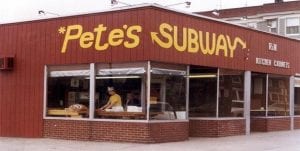
Pete’s Subway shop in Bridgeport, Connecticut, was the first of what is now the Subway sandwich restaurant chain. Photo from Reddit.
Bridgeport also elected a socialist mayor in 1933. Jasper McLevy served in that post for 24 years. McLevy proved to be a reformer who introduced programs to help workers. He also was known for his tight-fisted approached to the city budget. He was defeated in 1957 but remains the longest-serving mayor in Bridgeport history.
Bridgeport is also known as the birthplace of the Frisbee. The Frisbie Pie Company started here in 1871. During the 1900s, Frisbie employees used to fling the company’s pie tins during lunch breaks. Eventually, students from Yale and other colleges started to toss the pin tins around their campuses. In 1948, Walter Morrison adapted their plaything and developed a plastic version called the Flying Saucer. In 1955, Morrison perfected the design and in 1957 sold his invention to the Wham-O toy company as the Pluto Platter. Wham-O changed the name to Frisbee, a slightly different spelling than the pie company to avoid trademark issues.
The Subway sandwich chain also got its start in Bridgeport. In 1965, 17-year-old Fred DeLuca, who needed money to go to college, and Peter Buck, a physics professor and family friend, opened a sandwich shop they called Pete’s Super Submarines. In 1968, they changed the name to Subway. By 1974, they had 16 sandwich shops and started franchising their business. There are now about 20,000 Subways across the country. DeLuca died in 2015 and his sister, Suzanne Greco, took over the company’s operations from 2015 to 2018 before the reins were handed over to John Chidsey, the former chief executive officer of Burger King.
—————————————————-
Just 10 minutes up Interstate 95 is the town of Stratford, a community of 52,000 along the Housatonic River with religious origins and a place in helicopter history.
The settlement was founded in 1639 by as many as three dozen Puritan families who had fled England seeking religious freedom. They most likely named their community after William Shakespeare’s hometown. Some of the descendants of those original pioneers still reside in town. President Gerald Ford was a descendant of an original family.
The early economy was based on shipbuilding and oysters. In the mid-1800s, manufacturing became a mainstay. Products such as chemicals, electrical parts, paper products, hardware and plastics are still being produced.
Those industries provided local jobs, but there also has been an environmental price.
Stratford was the locale of two Superfund sites related to the disposal of hazardous materials by Raymark Industries.
Raymark owned a manufacturing plant in town. It had a division known as Raybestos that used the factory to manufacture brake pads and other automotive parts from 1919 to 1989. The company was so intertwined with the city that the local women’s softball team is called the Stratford Brakettes.
However, the waste products from the Raybestos operation included lead, PCBs and, as the company name implies, asbestos. Those excess substances were dried and made available as fill material for lawns, schoolyards and playgrounds in town.
At least 46 properties here were identified by the Environmental Protection Agency as contaminated. An initial cleanup began after the plant closed and was completed in 1997 at a cost of $200 million.
The waste products also invaded the Ferry Creek region. The final phase of this cleanup of nearby properties began in 2018. Some of the waste material will be buried and covered at the ballfield where the Brakettes used to play before they moved to their current stadium. The latest estimate on this clean-up is $140 million.
Another closed factory in town that needs a cleanup, albeit a smaller one, is the Stratford Army Engine Plant, which was located on 117 acres across the street from the city’s airport. The plant manufactured tanks, armaments and automotive components. It also produced the Corsair F4U fighter jets used against the Japanese in World War Two.

One of the items on display at the National Helicopter Museum in Stratford, Connecticut. Photo by Visit CT.
In 1985, there were 4,300 employees at the complex. It closed in 1998 as part of President Bill Clinton’s military base realignment plan. There have been proposals over the years to develop the property. Nothing has been finalized. First, the Army Corps of Engineer needs to clean up the PCBs left behind from the chemical waste that for years was poured into a drainage ditch.
One factory that is still operating is Sikorsky Aircraft. The company, now a subsidiary of Lockheed Martin, was founded by Igor Sikorsky, the Russian immigrant who is credited with being the inventor of the helicopter.
One of the world’s first successful commercial helicopters was made and flown here in 1942. The helicopters were an important military asset during the Korean War. Every Marine One helicopter used by presidents since 1957 has been manufactured here. In 2019, the plant was awarded a $540 million contract by the U.S. Navy to build six new Marine One choppers. In December 2020, the plant inked a $507 million contract with the U.S. Army for new helicopters.
Sikorsky also produces other helicopters such as those used in rescue and medical emergencies. The company remains Stratford’s largest employer.
In March 2022, Connecticut’s governor announced an agreement to provide financial incentives to Lockheed that will keep Sikorsky Aircraft in Stratford until at least 2042. In February 2024, the company was awarded a Defense Department contract to supply more Black Hawk helicopters. However, Sikorsky missed out on a bid to build new helicopters to replace the Black Hawks. This came after the company in fiscal year 2023 saw its smallest revenue request from the Pentagon in five years.
The National Helicopter Museum is located at a former railroad station in Stratford. It chronicles the history of helicopter manufacturing as well as other important aviation moments in town.
Stratford is also home to the Boothe Memorial Park & Museum. The 32-acre estate of brothers David and Stephen Boothe was originally built in the 1820s. The current buildings include a 77-foot clock tower, a carriage shop, a Dutch windmill, a blacksmith shop, a miniature lighthouse and a redwood cathedral.
Remembering the Schoolchildren
We break away from the coastline for a quick jaunt to an inland town that has become forever linked with the tragedy of school shootings.
To get there, we head north on Highway 25 for a half-hour until we reach Newtown, a community of 27,000 residents that was thrust onto the national scene on December 14, 2012.
That’s when a distraught young man named Adam Lanza, armed with semiautomatic weapons, strode into Sandy Hook Elementary School and killed 20 young students and 6 school employees before killing himself.
The outcry and grief over the killings were expressed worldwide. It was felt by people who had never been to Newtown and by those who had.
One person who felt it was former Newtown resident Caitlyn Jenner.
Jenner attended Newtown High School when she was known as Bruce Jenner. She spent her junior and senior years here and competed in football, basketball and track before graduating in 1968. Jenner said a few days after the massacre that “Not in a million years would you ever think that this quiet little town would have such a terrible, terrible tragedy happen there.”
The mass murder also sparked a national debate on a number of issues.
For starters, it was reported after the shooting that Lanza had “significant mental health issues that affected his ability to lead a normal life and to interact with others.” However, mental health professionals who had worked with him “did not see anything that would have predicted his future behavior.”
In the months after the Sandy Hook murders, there were discussions about the mental health of people who commit mass shootings. One report estimated that 60 percent of perpetrators of mass shootings since 1970 displayed symptoms of mental health illnesses before their killing sprees.
The president of the National Rifle Association (NRA) blamed “delusional killers” for the violence and called for a national registry of people with mental health issues. Several states passed laws that required mental health professionals to report “dangerous patients” to law enforcement authorities who could then confiscate any guns that person owned.
The 21st Century Cures Act, which introduced major mental health reform programs, was approved by Congress and signed by President Barack Obama in 2016. However, it has been plagued by funding issues.
In Congress, a debate erupted over Second Amendment rights and gun control. A ban on semiautomatic weapons that was approved in 1994 had elapsed in 2004. Some legislative leaders and President Obama promised to introduce gun control legislation. NRA officials suggested that armed guards be posted at schools.
The Assault Weapons Ban of 2013 that would have banned the sale of 150 types of firearm models as well as magazines that hold more than 10 rounds of ammunition was introduced. However, it went down to defeat in the Senate.
The Manchin-Toomey Amendment, which would have instituted universal background checks for firearm sales, also failed to pass the Senate.
The lack of action in Congress prompted states to get involved. In the first five years after the Sandy Hook mass shooting, there were 210 state laws enacted to improve gun safety. Some of that legislation included background checks.
In 2017, the NRA-backed Concealed Carry Reciprocity Act was approved by Congress and signed by President Donald Trump. The law allows people who have a concealed carry permit in one state to carry concealed weapons in all states.
Despite that legislative victory, the Sandy Hook massacre did apparently cause a fracture within the NRA. Several senior level officials reportedly recommended the organization take a less confrontational approach on gun control in the aftermath of the massacre. However, NRA President Wayne LaPierre, urged on by other officials, said in 2019 his organization would organize a campaign to train armed guards for schools as well as oppose any new gun control measures. That’s when LaPierre delivered his line: “The only thing that stops a bad guy with a gun is a good guy with a gun.”
In April 2021, President Joe Biden authorized six executive actions to curb gun violence in the wake of several mass shootings.
In June 2022, President Biden signed a gun safety law that provides incentives to states to approve “red flag” laws that allow groups to petition courts to take away guns from people deemed to be a threat. The bill also strengthens provisions to prevent people convicted of domestic abuse from owning weapons. The law was passed after a school shooting in Uvalde, Texas, that killed 21 people and a supermarket shooting in Buffalo, New York, in which 10 people died.
In January 2024, the president signed another executive order that helps promote safe gun storage in homes and other places.
——————————–
Amid all the political strife, the community of Newtown, in particular the parents of the children who died, have taken action on their own.
In 2014, the families of nine of the children who were killed filed a class-action lawsuit against Remington Arms, the maker of the guns used by Lanza. Their focus was a 1995 law that protects gun manufacturers from legal consequences over acts committed by gun owners. In March 2019, the Connecticut Supreme Court reinstated the lawsuit after a lower court had tossed it out. That lawsuit was halted in September 2020 when Remington filed for bankruptcy and began selling off its assets. In February 2022, the families reached a $73 million settlement with Remington.

Scarlett Lewis with her son, Jesse, before the Sandy Hook school shooting. Photo courtesy of Scarlett Lewis.
In September 2019, the Sandy Hook Promise organization released a back-to-school video that graphically showed the issue of gun violence in schools.
Scarlett Lewis, whose 6-year-old son Jesse Lewis was killed in the shooting, is taking a different approach.
After her son’s death, Lewis formed the Jesse Lewis Choose Love Movement to help children and adults deal with issues that crop up in everyone’s lives.
“I wanted to do something different because there was a lot of focus on the issues and all of the combined efforts and money and all that was not necessarily working,” Lewis told 60 Days USA in 2021. “I wanted to do something that would make a difference.”
The foundation instructs people on social and emotional intelligence as well as character development. It uses neuroscience, mindfulness training and post-traumatic growth strategies. It guides people on how to have healthy relationships, how to express emotions and how to have the courage to make the right choices. It teaches them the power of being grateful and the power of forgiveness.
“You can choose your response in any situation even if you can’t choose what happens to you,” Lewis said.
Lewis often talks about her son Jesse’s bravery on the day of the shooting. He is credited with directing other children to safety before he was shot. On that morning, he had written the message “Nurturing Healing Love” on the family’s kitchen chalkboard.
“I felt that if Jesse could stand up to the shooter and save nine of his classmates’ lives, then certainly I could honor that bravely and stand up,” Lewis said.

Children wearing bracelets with the Choose Love Formula on them. Photo from the Jesse Lewis Choose Love Movement.
Another motivation is that Lewis has another son who is now a young adult. She said the tragedy taught her how to model resilience and post-traumatic healing for her oldest son.
“It helped me rise to the occasion and try to be the best version of myself for him,” she said. “We have a good life now, even though we miss Jesse every day.”
Lewis said she is encouraged by the response to the Jesse Lewis Choose Love Movement. Their programs are now being taught in more than 14,000 schools in all 50 states as well as in 120 countries.
“I see a world where every child has access to social and emotional learning,” Lewis said, “where individuals are able to manage their emotions and deal with difficulty and challenges that happen in their lives and literally be strengthened by them and grow through them rather than being taken down by them and take other people down by them.”
“I see a world where people choose love instead of hate and that it’s a choice,” she added.
——————————–
Sandy Hook Elementary School was torn down in 2013. A new school was built in its place.
In 2013, General Electric announced plans to donate $15 million to help build a community center in Newtown. The center was officially opened in July 2019.
Lewis said her town was buoyed by the worldwide response that sent thousands of letters and gifts their way.
She said there is still a lot of struggle in her town. People are still trying to overcome grief and fear. There are anniversaries and other events that remind them of that day in December 2012.
“I think the Sandy Hook community will be healing for a long time,” Lewis said.
———————————-
Before the 2012 shooting, Newtown was a small, relatively peaceful town with a place in the history of board games.
Newtown was founded in 1705 when English colonists purchased land from the Pootatuck tribe. The town was incorporated in 1711 and was a British loyalist stronghold during the Revolutionary War.
In the 1800s, it was initially a farming community, then a railroad stronghold and then a manufacturing center. Products ranged from furniture to tea bags to combs to fire hoses to buttons.
Today, many residents commute to jobs in New York City and Hanford, Connecticut. Others work in white collar jobs at General Electric, Pepsi and IBM offices nearby.
Most folks seem to do well. The median annual household income is $142,000 and the poverty rate sits at 2 percent. The median price of a home is about $590,000.
Newtown does have its slot in board game history. It’s the place where “Scrabble” was developed.
The game was invented in 1933 by Alfred Mosher Butts, who studied New York Times crossword puzzles in order to figure out how many points to award to certain letters of the alphabet. In 1948, Butts sold the rights to manufacture the game to Newtown resident James Brunot in exchange for being paid royalties on every game sold.
Brunot made some minor changes to Butts’ game and then changed the name from “Criss-Cross Words” to “Scrabble” after a Dutch word meaning to grope around for something.
In 1948, Brunot and his family started making the game in their home before they turned a former schoolhouse into a manufacturing facility.
They initially lost money, but in 1952 Macy’s president Jack Straus played Scrabble while on vacation and was surprised to learn his store didn’t carry the game.
Straus put in a large order and sales skyrocketed from 4,800 games in 1951 to 3.7 million games in 1954. Brunot couldn’t keep up with demand, so he sold the product to Selchow and Righter in 1953.
Butts and Brunot, however, kept their rights and collected payments until the early 1970s.
Today, Scrabble is owned by Hasbro nationally and Mattel internationally. It’s estimated that one in three U.S. households has the game. Scrabble was inducted into the National Toy Hall of Fame in 2004.
Cotton, Muskets and Hamburgers
From Newtown, we travel southeast on Highway 34 through state forests and farmland on our way back to the Connecticut coastline.
After a 45-minute drive we reach New Haven, a community of more than 140,000 people that is the second most populous city in Connecticut as well as home to Yale University. It was also once a gun manufacturing center inspired by a Yale graduate who invented the cotton gin.
The region was originally home to the Quinnipiac tribe that lived along the shore, fished and grew maize. Dutch fur traders did sporadic business with tribe members in the 1600s.
The town was founded in 1638 by 500 English Puritans who had left the Massachusetts Bay Colony. They purchased their land from the Quinnipiac with the promise they’d protect them from attack from other tribes.
In 1639, New Haven became the country’s first planned community after eight streets were laid out in a four-by-four grid known as the “Nine Square Plan.” The layout formed the New Haven Green, a 16-acre privately owned park downtown.
Yale University moved to New Haven in 1718 and was named after local merchant Elihu Yale. It’s the fourth oldest university in the country. The 12,000-student institution is the one of the biggest employers in New Haven.
In 1794, Yale graduate Eli Whitney patented the cotton gin, an invention he developed while at a plantation in Savannah, Georgia. The importance of this new device should not be understated. It greatly sped up the cotton manufacturing business by removing the seeds from picked cotton mechanically rather than by hand. The word gin, in fact, is short for engine.
Due to the cotton gin, the yield of raw cotton in the country doubled every decade after 1800. This provided more cotton for Northern textile mills and allowed Southern farmers to increase their cotton acreage. That, in turn, increased the South’s need for slaves. By the mid-1800s, cotton was the country’s leading export as it produced 75 percent of that crop worldwide.

Inside the Eli Whitney Museum and Workshop in New Haven, Connecticut. Photo by Workshop Shed.
Whitney, however, failed to make much money off his invention due to a number of patent infringements. So, in 1798, he secured a federal government contract to manufacture 10,000 muskets over a two-year period.
Whitney established a firearms factory in New Haven, using an interchangeable parts production process similar to the one used for the cotton gin. The inventor made a sizeable amount of money over the next couple decades, especially during the War of 1812.
Whitney died in 1825 at the age of 60 and is buried in a New Haven cemetery. His firearms factory is now the Eli Whitney Museum and Workshop.
Whitney’s company wasn’t the only firearms game in town. The New Haven Arms Company became the Winchester Repeating Arms Company and operated in town until the factory closed in 2006.
The Civil War boosted the local economy due to the high demand for firearms.
Weapons, however, weren’t the only thing manufactured in New Haven during the 1800s. Factories also produced carriages, clocks and brass hardware.
These factories brought in a flood of European immigrants in the second half of the 1800s. Irish and Jewish immigrants came first, followed by immigrants from Italy. Today, more than 40 percent of East Haven residents are of Italian-American heritage.
During World War Two, African-Americans from the South came to work in the factories. New Haven remains an ethnic mix today, in part because of immigrants. It’s listed as 30 percent Black, 30 percent Hispanic or Latino and 32 percent white.
After World War Two, residents and business began to move to the suburbs, so city leaders took action.
Some of the nation’s earliest urban renewal programs began in New Haven in the 1950s. More than $300 million was spent on renewal projects during Mayor Richard Lee’s eight terms in office from 1954 to 1969. One of the main projects was the rebuilding of the downtown area, which was completed in 1965.
Since 2000, the downtown has been revitalized with restaurants, retail stores and night life spots. New Haven has also become known for its pizza joints.
The economy today centers on education and healthcare as well as professional and financial services.
The city is known as the “cultural capital of Connecticut” due to its museums, theaters and music venues. New Haven is also known as “The Elm City” because of its tree planting program that started in 1868, the first such project in the nation.

Louis Lunch restaurant in New Haven, Connecticut, where the hamburger was reportedly invented. Photo by Connecticut Magazine.
The Knights of Columbus began in New Haven. It was founded in 1882 and still has its headquarters and museum here.
New Haven has some business notoriety, too.
George Smith, a local confectioner who worked for the Bradley Smith Candy Company, is credited with inventing the lollipop in 1908. It was initially called the Lolly Pop and sold for one penny.
The Ann Taylor clothing store also started here, establishing itself in 1954. The store closed in July 2020 after its parent company filed for bankruptcy.
And Louis’ Lunch is recognized as the oldest hamburger shop in the United States. The restaurant opened in 1895 and moved to its current location in 1917. It served its first hamburger in 1900 when a customer wanted a quick meal and proprietor Louis Lassen slapped some steak trimmings between two pieces of toast.
The restaurant is on its 4th generation of family management. They make their hamburgers pretty much the same way Louis Lassen did and, per his tradition, they offer no condiments other than cheese, tomato and onion. That’s right. Hold the ketchup. Hold the mayo. Hold the mustard.
When we visited on a Thursday in July 2023, a line had formed shortly after the noon opening. Inside, the small eatery was packed with people sitting in the few seats available and others clustered around the walls waiting for their order.
George Wall, an art dealer from New Bedford, Massachusetts, was there, stopping by for a lunch before meeting with officials at the Yale Art Gallery.
Wall told 60 Days USA he’s been to Louis Lunch about 50 times, grabbing lunch there anytime he is in town or on his way to New York City. He said there is almost always a line at noon, especially when Yale students are in town for classes.
He keeps coming back for a number of reasons.
“There’s a good atmosphere and a great history and they have the best cheeseburgers around,” Wall said.
Inside, the two workers at the counter kept shoveling out the burgers. They said they make 600 to 700 of them on an average day.
Movie Inspirations Along the Shore
Interstate 95 hugs the Connecticut shoreline and after an hour we arrive in Mystic, a seaport community of 4,000 people made famous by a 1980s movie starring Julia Roberts.
The Pequot tribe lived for centuries in this region along the Mystic River. In 1637, British forces and other tribes attacked the Pequot in what became known as the Mystic Massacre. As many as 1,500 Pequot tribe members were eventually killed.
English settlers began arriving in the 1640s. The village was officially settled in 1654 and named after the Pequot word “miss-tuk,” which refers to a large river driven by waves and tides.
In the late 1600s, the economy was centered on livestock, crops and furs that were transported along the Pequot Trail.
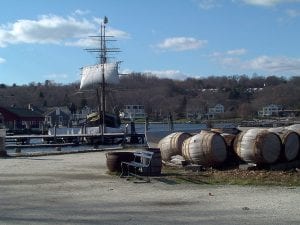
The seaport in Mystic, Connecticut. Photo by Wikivoyage.
In the 1700s and 1800s, Mystic became a shipbuilding and whaling center along with the nearby towns of New London, Nantucket and New Bedford, which were the three largest whaling ports in the world at the time. In 1857, this coastline had 447 whaling ships, accounting for 64 percent of the whaling tonnage in the United States. In addition, more than 600 ships were built along the Mystic River corridor between 1780 and 1920.
Agriculture, maritime trade, road building and textile manufacturing were other local industries.
The village economy today partly relies on its port and B. F. Clyde’s Cider Mill, the only steam-powered cider mill in the United States.
The standard of living is comparatively high. The median annual household income is $115,000. The average home costs more than $700,000.
Tourism is another major economic component. That industry was helped in 1988 when the movie, “Mystic Pizza,” debuted. The film, which centers on three women who work at a pizza restaurant in a seaport town, was mostly shot in Mystic. There is a Mystic Pizza restaurant here and it was reportedly the inspiration for the movie’s screenwriter when she spent a summer in town. However, the restaurant was not used in the filming as it was too small. An indoor studio was used instead.
Among other things, Mystic is a popular place for weekend getaways as well as weddings. Hollywood legends Humphrey Bogart and Lauren Bacall honeymooned at the Inn at Mystic.
The village is also home to the Mystic Seaport Museum, the leading maritime museum in the country. It includes old whaling ships such as the Charles W. Morgan, the last wooden whaling ship in the world. The museum was founded in 1929 and honors the maritime history along this part of Connecticut and Massachusetts.
There’s also the Mystic Aquarium, a research center known for its beluga whales.
It should be noted that technically Mystic isn’t a town. It’s a zip code/village that is part of the communities of Groton and Stonington. The village is divided into two parts, separated by the Mystic River.
——————————–
The heart of Stonington is just 10 minutes from Mystic along Highway 1.
This community of 1,000 people near the Rhode Island border has become a home for writers, including one who wrote a novel that became the country’s first summer blockbuster movie.
The region was settled by European colonists in 1649, who established a trading post on land that belonged to the Pequot tribe. It received a charter in 1662 and calls itself Connecticut’s oldest village.
In the 1790s, Stonington was a port for the seal hunting industry as well as a shipbuilding and whaling center. Today, it remains the home of the state’s last commercial fishing fleet.
The railroad arrived here in 1837, along with steamship service.
There were two main factories in town. One was for horseshoe nails that opened in 1851. The other was the American Velvet Company that operated from 1890s to 1998. The factory is now an artists’ enclave.
Another industry that has arrived in Stonington is marijuana. The town’s residents approved a ballot measure in 2021 legalizing cannabis businesses. Facilities were allowed to apply for permits in January 2023 and at least three dispensaries have opened in the area.
The Stonington Harbor Lighthouse was built in 1840. It was the first lighthouse established by the federal government. It operated until 1889 and housed lighthouse keepers’ families until 1909. The structure is now the Lighthouse Museum. The items inside include artifacts from an 1814 encounter between British warships and soldiers where the local troops held off the assault for three days. The historical society now keeps a Stonington Battle Flag from that confrontation. They called it the “little sister” of the Star Spangled Banner.
One of the more famous buildings in town is the James Merrill House. In 1954, this was the home of poet James Merrill and his partner, David Jackson. Merrill won the Pulitzer Prize for poetry in 1977 for his book “Divine Comedies.” Merrill died in 1995 at the age of 68. After that, the Stonington Village Improvement Association took over the house. The home is now used as a writers-in-residence facility where seven writers per year stay and work.
One writer who didn’t stay at the Merrill home but still used Stonington for inspiration was Peter Benchley. He wrote the final draft of his best-selling book “Jaws” in a turkey coop on Elihu Island just off Stonington. He was frequently seen in town during that time.
The book “Jaws” was eventually turned into the 1976 film that was directed by Steven Spielberg. “Jaws” is credited with starting the trend of releasing big budget movies during the summer.
The film made Benchley famous. Later, he said he regretted how the shark was portrayed in the movie. Benchley and his wife ended up being activists for the preservation of the ocean.
On the Road in Rhode Island
We turn away from the ocean for the final leg of today’s trip.
From Stonington, we hop onto Interstate 95 and head inland in a northeasterly direction.
Within minutes, we cross the state line into Rhode Island.
It’s a state that’s at the top and bottom of a lot of lists.
Rhode Island is the smallest state at only 1,545 square miles, almost 1,000 square miles smaller than 49th place Delaware. It’s known as the Ocean State because it has more than 400 miles of coastline.
Rhode Island is also 44th in population with slightly more than 1 million residents. It doesn’t have a city within the top 150 most populous in the country. However, it’s the second most densely populated state with 1,062 residents per square mile, behind only New Jersey.
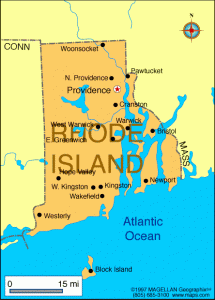
It used to have the longest state name. Throughout most of its history, it was officially known as the “State of the Rhode Island and Providence Plantations.” However, in November 2020, voters decided to shorten the name to just the “State of Rhode Island,” passing the long-name title to the Commonwealth of Massachusetts.
Rhode Island was founded in 1636 by Roger Williams, who had been forced out of the Massachusetts Bay Colony for his religious views. Williams believed in the separation of church and state as well as in religious tolerance. He was opposed to taking land from Native American tribes.
Williams and his followers set up a settlement in Narragansett Bay. It became a haven for Baptists, Quakers, Jews and other religious minorities.
Rhode Island also officially abolished slavery in 1652, but those laws were not enforced. The state eventually developed into a northern epicenter for the slave trade.
Brown University was established in 1764 and accepted students of all religions.
On May 29, 1790, Rhode Island became the 13th and last of the original colonies to join the Union.
Rhode Island was an early leader in the Industrial Revolution. It had water-powered textile mills and the second cotton mill in the country.
The industries brought in people from other states looking for jobs. Most of them didn’t own property, so they couldn’t vote. In 1829, in fact, 60 percent of Rhode Island’s free white men weren’t eligible to vote. In 1843, the state passed a law allowing non-property owners to vote if they paid a $1 poll tax.
In 1866, Rhode Island abolished school segregation.
From 1866 to 1916, the state enjoyed a Gilded Age with large summer homes built at Newport and other seaside towns.
During the 1800s, Rhode Island suffered through a hysteria over tuberculosis, a period known as the “vampire panic.” It began when family members of people who had died of the disease would show symptoms of infection. Some people believed the dead were “consuming” the life of their relatives from their graves, leading to the alternative name of “consumption” for tuberculosis. Bodies were dug up and organs of the dead were burned.
In the 1920s and 1930s, the Ku Klux Klan experienced a surge here and in other New England states due to the adverse reaction to immigrants who came to work in the factories.
Rhode Island also has a progressive side. It has comprehensive health insurance for children. Medical marijuana was approved in 2006. Same-sex marriage was given the OK in 2013.
The state’s colonial economy centered on fishing before switching to manufacturing in the 1800s. That faded when textile mills moved to the South in the 1900s. The top manufacturing sectors today include electrical equipment, jewelry and silverware. General Dynamics Electric Boat has a facility at Quonset Point where they build nuclear submarines for the Navy.
The state’s official appetizer is calamari, a fact that made quite a splash in a video shown at the virtual Democratic National Convention in August 2020.
The official state drink is coffee milk, a mixture of cold milk with coffee syrup that was first sold in the 1930s.
——————————————-
Almost an hour after leaving Stonington, we finish this day’s journey at a city known for coffee as well as doughnuts.
Providence is Rhode Island’s state capital as well as its most populous city with nearly 190,000 residents and third most populous city in New England, behind only Boston and Worcester, Massachusetts. Providence’s ethnic breakdown is 42 percent Hispanic or Latino, 34 percent white and 15 percent Black.
The city was founded in 1636 by Roger Williams, who named the town after “God’s Providence” for showing him this haven. It’s one of the oldest cities in the United States.
Providence was a stronghold for anti-British sentiment leading up to the Revolutionary War, including its own version of Boston’s tea party where that product was burned in protest against taxation.
After the Revolutionary War, Providence followed Rhode Island’s lead and became one of the first cities to industrialize. It was known for textile manufacturing as well as machine tools, jewelry and silverware.
By 1900, the city had some of the largest manufacturing plants in the country, producing steam engines, tools, screws, silverware and textiles. It was one of the most prosperous cities of the early 20th century and had a high percentage of immigrants. The Federal Hill neighborhood just west of downtown is known for its Italian heritage and influence.
In the 1990s, the city spent millions to remove railroad tracks and uncover rivers as part of a downtown renovation.
Today, Providence is more of a service industry economy. It’s home to eight hospitals and seven institutes of higher learning, including Brown University. The college has 10,000 students and is one of the city’s largest employers.
In recent years, Brown has also been working to reduce the number of sexual assaults on campus. In 2014, it was tied with the University of Connecticut for the most reported rapes of any college in the country. Brown officials formed a 23-member Sexual Assault Task Force that fall.
In 2019, the university released results of a sexual assault survey that reported nearly 25 percent of female Brown students had experienced non-consensual sexual contact. About 48 percent said they had experienced various forms of sexual harassment. University officials said the report also showed increased awareness among Brown students of the problem of sexual assault as well as what resources are available.
In February 2021, members of the University Survivors Movement held a protest on campus, asking Brown officials to do more to solve the problem. In March 2021, university officials unveiled a new system for reporting sexual harassment and other misconduct, including a provision that allows to make anonymous accusations against another person on campus.
A lawsuit filed in August 2021 stated that Brown University has systematically failed to protect women from sexual assault. Another lawsuit was filed in September 2023 against the university.
Brown University is not the only campus dealing with this issue. In 2019, that nationwide survey reported that one in four women at 33 large universities said they had experienced sexual assault while they were students. Fewer than 30 percent of these women filed an official complaint. The Rape, Assault & Incest National Network (RAINN) reports that 13 percent of all students experience rape or sexual assault through physical force. For undergraduate students, 26 percent of females and 6 percent of males experience rape or sexual assault through physical force.
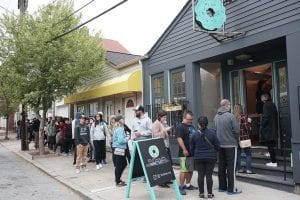
PV Donuts in Providence, Rhode Island, is a popular spot in a city filled with doughnut shops. Photo by The Providence Journal.
Providence does have its historical aspects.
The dome on the state Capitol is the fourth largest unsupported dome in the world.
The Arcade Providence, built in 1828, was the nation’s first enclosed shopping mall. It’s still in operation today with 48 micro-loft apartments on the upper floor and retail establishments on the first floor.
Providence is also home to the Waterfire sculpture, which consists of 100 bonfires that light up the waters of the three rivers that flow through downtown. The line on bonfires rolls along for nearly two-thirds of a mile. The display is typically aflame from May to November on most Saturdays.
Finally, Providence has the most coffee and doughnut shops per capita of any city in the country.
Probably would be a good place to start tomorrow morning.
Day 28 will be all about Massachusetts. We will explore a famous pond, the sites of two of the most famous Revolutionary War battles and a village with a bewitching history where I have a 9-generation personal connection.

